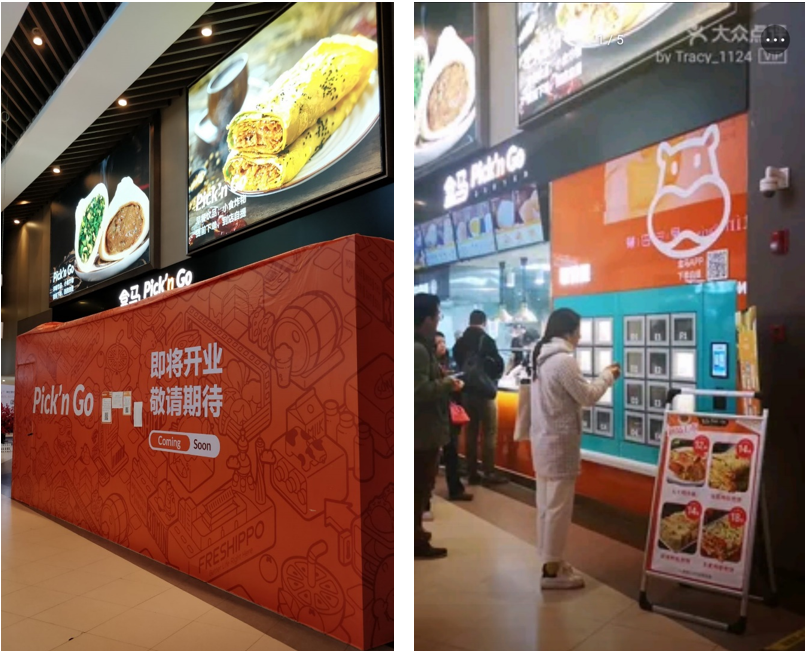
Note: Alibaba calls Freshippo (yes, with one ‘h’) in English, but in this series, we’ll continue to use Hema because it is easier to differentiate the different concepts using this name.
In the first part of this series, we described how Alibaba launched the Hema Xiansheng supermarkets in 2016 as one of their New Retail initiatives. The stores soon became popular, but Hema also quickly realized that there were limits to its growth. Full-blown Hema Xiansheng stores were a costly investment of RMB 20-30 million, and they needed a dense population of middle-class consumers within a 3 km radius to become popular. That requirement was not met outside the first- and second-tier cities and often not even in the suburbs of such cities.
Hema realized it needed to differentiate its retail concept to reach new regions and different consumer demographics. More recently, Hema CEO Hou Yi said at the Hema New Retail Supply Conference that it wants to reach one trillion yuan in sales and service one billion customers. To reach that goal, having Hema Xiansheng stores in the higher tier cities won’t be enough. That’s why Hema has been testing several other concepts through the years.
Under the Hema brand, Alibaba has tried no less than 12 formats (plus several related initiatives we’ll get to in part 4 of this series).

Many formats launched in 2019 tried to solve the problem of reaching consumers that the regular Hema Xiansheng stores could not reach, either geographically or because of consumers’ budget restraints. Hema Xiansheng, Hema X and Hema Mini are all targeted at the middle-class consumer, while concepts like Hema Neighbourhood and Hema Outlet serve the ‘common people’ like the elderly and people of lower income classes. [1]
In this second part of the series, we have a closer look at the many concepts launched in 2018 and 2019. In the next part, we will examine the concepts launched in 2020 and beyond.
Hexiaoma (盒小马)
After Alibaba became a shareholder of Sun Art retail in 2017, Hema and Sun Art’s hypermarket formula RT-Mart teamed up to create Hexiaoma. The ‘ma’ in Hema means horse, and ‘xiao ma’ means pony. As the name implies, Hexiaoma was meant to be a smaller version of Hema Xiansheng. It became the very first Hema spin-off.
Hexiaoma was presented as a medium-sized boutique supermarket extension of the Hema brand for downtown areas in first- and second-tier cities. The stores would use Hema’s technology, offer catering stalls and focus on imported seafood and private labels. RT-Mart would be responsible for the supply chain and store management of these small supermarkets launched in June 2018. Like Hema, Hexiaoma also offered home delivery in a 3 km radius, although it can take up to one hour, compared to Hema’s 30 minutes.
The first store was opened in Suzhou in June 2018 and was 800 square meters large. It looked like a cross between a Hema and a convenience store. Just two months later, in August 2018, Hexiaoma began testing a franchise model and opened this up in October. By January 2019, there we 16 stores in total, only two of which were self-operated. But the first store in Suzhou already closed after ten months, allegedly because of poor location choice, and by mid-2019, only two new stores had been opened that year.
RT-Mart tried building on its strong presence in third- and fourth-tier cities and suburbs of larger cities to expand Hexiaoma to small stores of 1,000 – 2,000 square meters. Eventually, the product mix became more ‘RT-Mart’ than ‘Hema’. It had less fresh food and products like sportswear and home furnishing that you wouldn’t find at Hema. Ultimately, Hexiaoma ended up being more like a small community store.
Hexiaoma was also added to Alibaba’s online grocery delivery platform Taoxianda, which itself was part of Tmall Supermarket. The goal was to combine the strengths of Hema, RT-Mart and Tmall to create ‘the next Hema’. [2] Instead, it created a failure waiting to happen. And to make things even more complicated, another Hema concept, Pick ‘n Go, would later be rebranded to Hexiaoma.
We’ll get back to Hexiaoma when we discuss Pick ‘n Go.
Image: Sina news.
Explosion of new format
Despite its popularity, it’s not been smooth sailing all the way for Hema Xiansheng. Between 2016 and 2019, it grew from 6 to 85 stores, but sales per square meter continued to decline from RMB 56,000 for the first store in 2016 to 20,000-30,000 for all stores in 2018. As a result, Hema decided to launch differentiated concepts for different target groups. [3]
In March 2019, Hema CEO Hou Yi announced that several new store types would be added to the Hema brand:
- Hema F2 (盒马F2)
- Hema Farmers’ Market (盒马菜市, Hema Cai Shi)
- Hema Mini (盒马mini)
- Hema Small Station (盒马小站, Hema Xiao Zhan)
- Hema Pick ‘n Go
In early 2020, Hema released the following video about these new formats.
Let’s have a closer look at these concepts launched in 2019, most of which have already disappeared.
Hema F2 (盒马 F2)
Hema F2, which actually already launched in November 2017, was a convenience store concept with an area of about 500 square meters and catering as the core business, including fast food, tea, snacks, lunchboxes, etc. It was targeted at businesspeople and located in office areas in business districts. The F2 stands for ‘Fast & Freshmade’ (or ‘freshade’ according to the signs in the picture below). The Hema F2 concept seems to have disappeared from the market, never having made much of a splash.
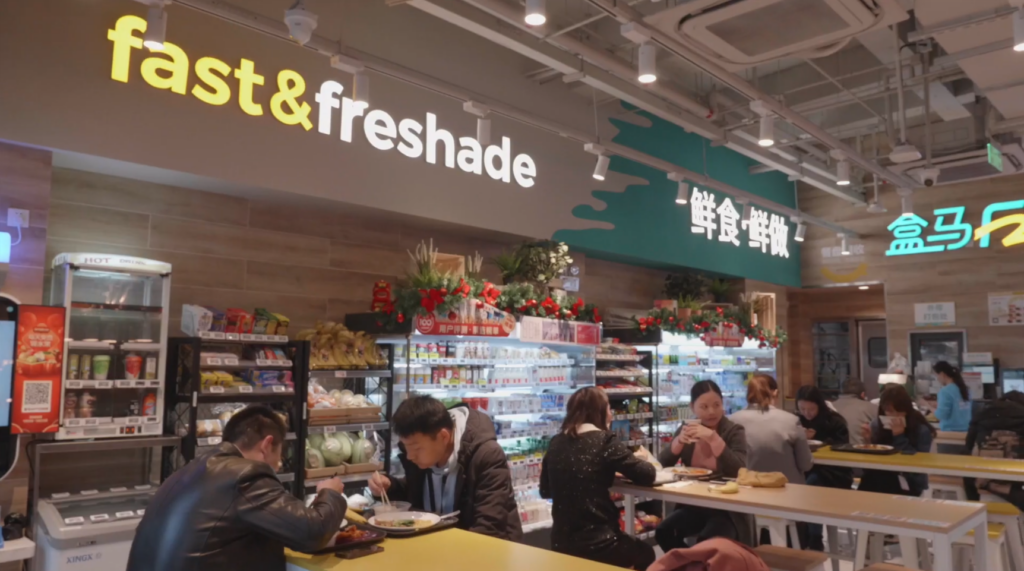
Hema F2 (source: still from Alibaba video)
Hema Farmers’ Market (盒马菜市)
Hema Farmers’ Markets were located near large residential communities and in the suburbs. In Shanghai, I visited a Hema Market in 2019. The similarities and differences immediately struck me after seeing several regular Hema Xiansheng stores in different cities. Clearly, this new concept under the Hema umbrella was aimed at a quite different target group, namely the middle-aged, more price-conscious generation who normally shops at the traditional ‘wet market’ where individual traders display their fruit, vegetables, meat and fish on large tables.
Walking around in a Hema Market felt like shopping in a cross between a regular Hema Xiansheng store and such an old ‘wet market’. Compared to such a Hema Xiansheng store, you would find less trendy catering and a smaller version of the ‘seafood’ department Hema Xiansheng had become so famous for and which appealed to the younger target group. Instead, there seemed to be a greater emphasis on vegetables.
Hema Market also offered 30-minute home delivery. According to reports in the trade press at the time, future Hema Markets would also have services such as laundry, hairdressers, fitness, childcare, etc.
The few Hema Farmers’ Markets that opened have all closed.
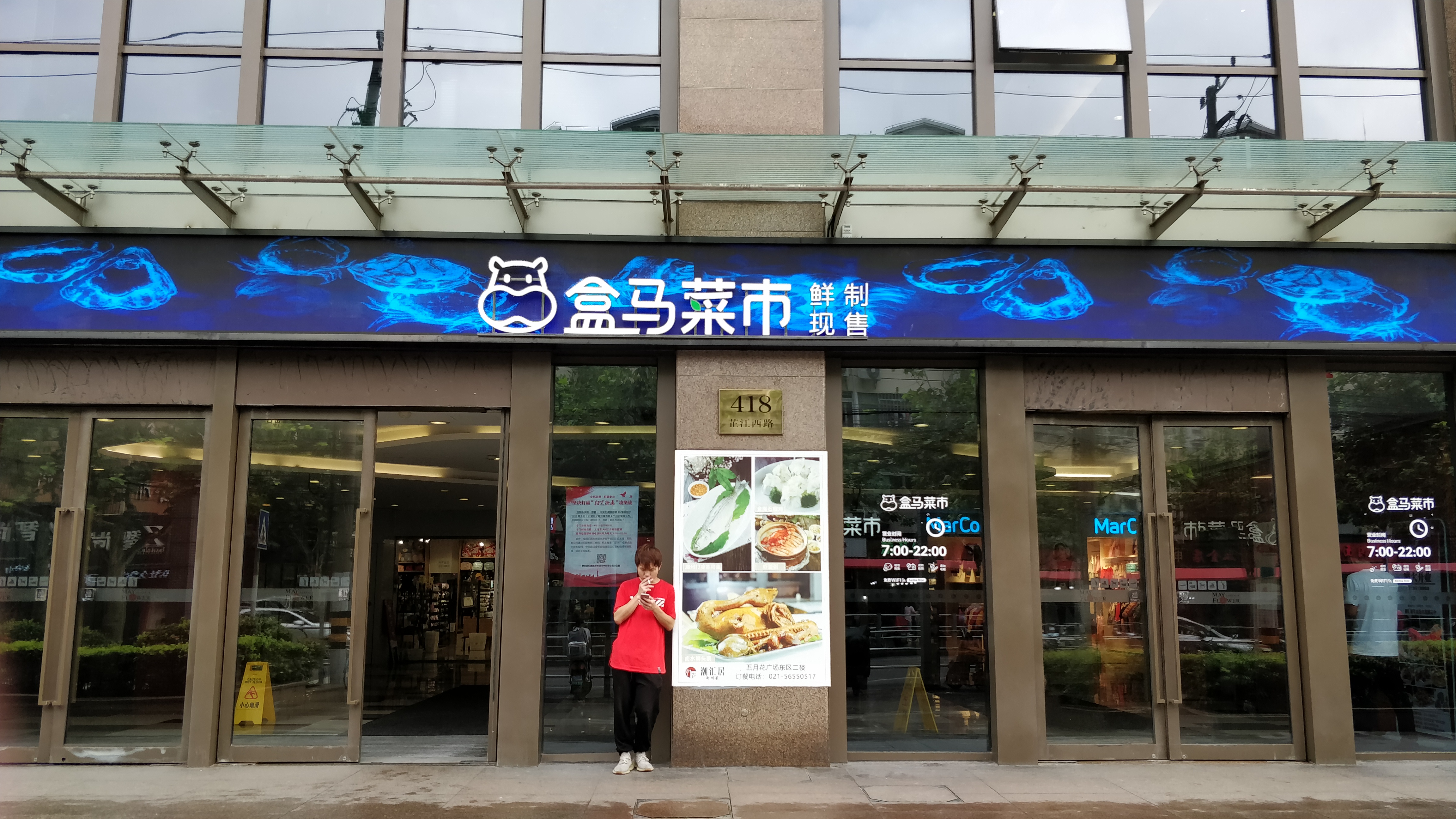
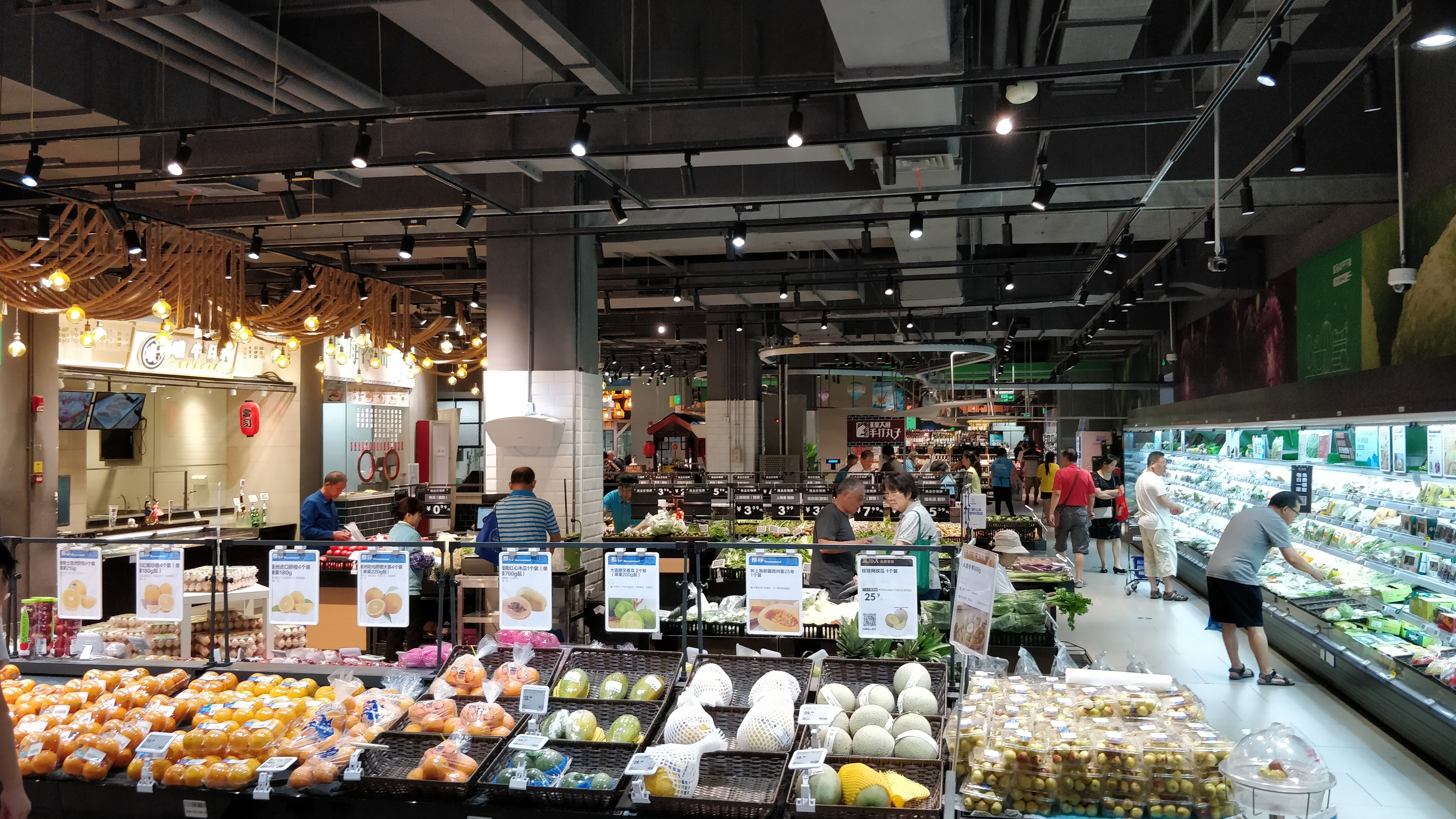


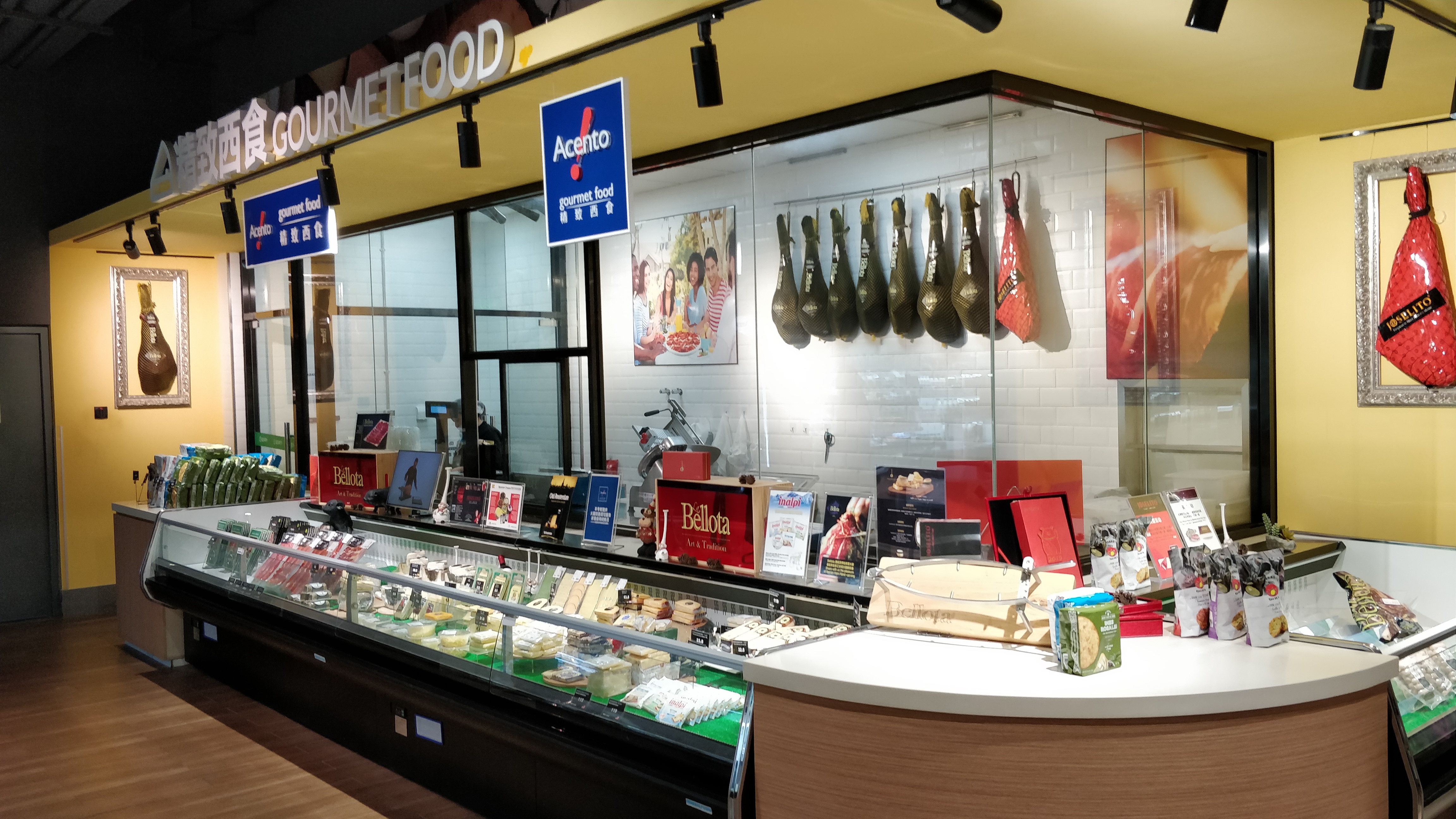
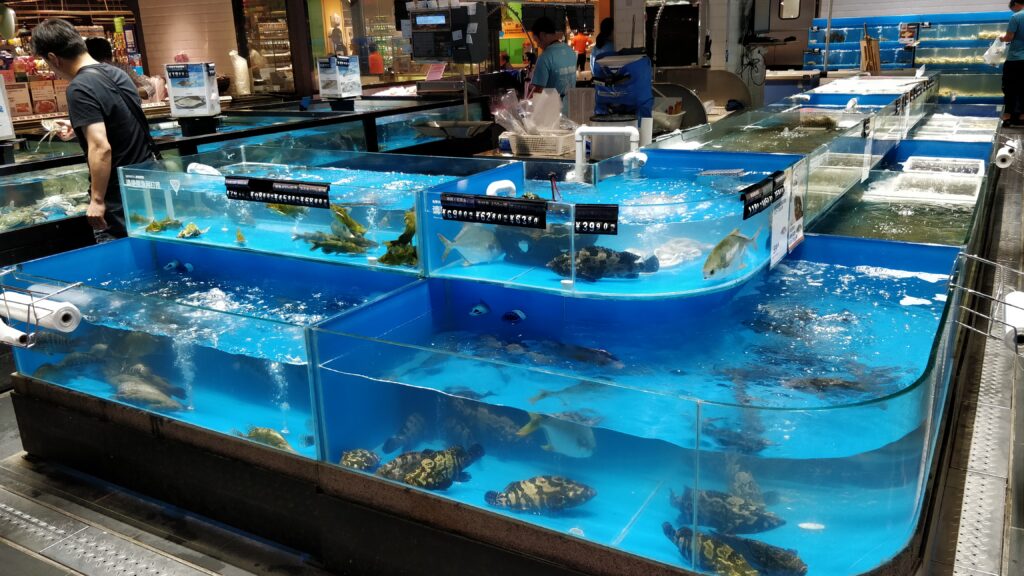
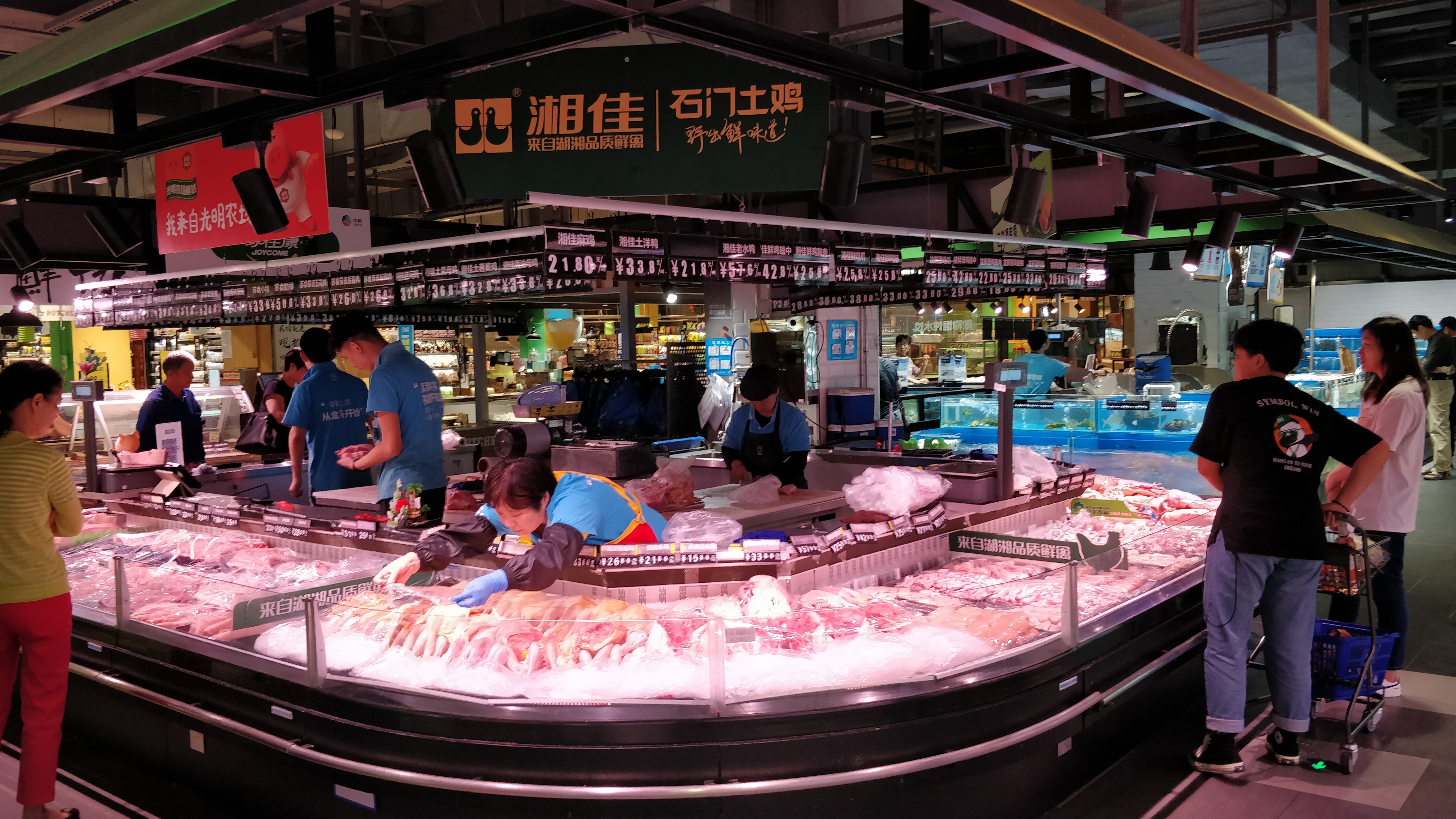
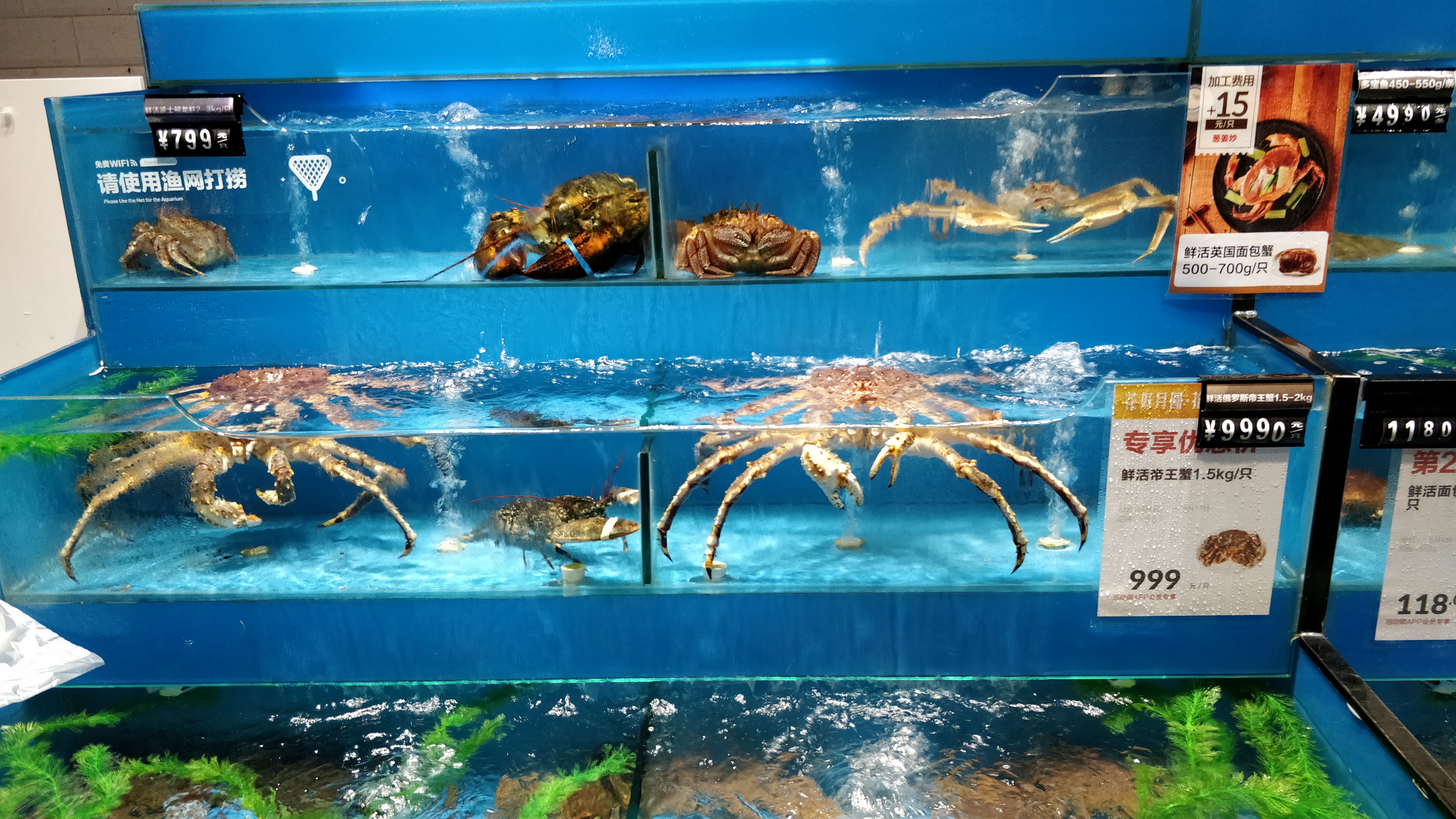

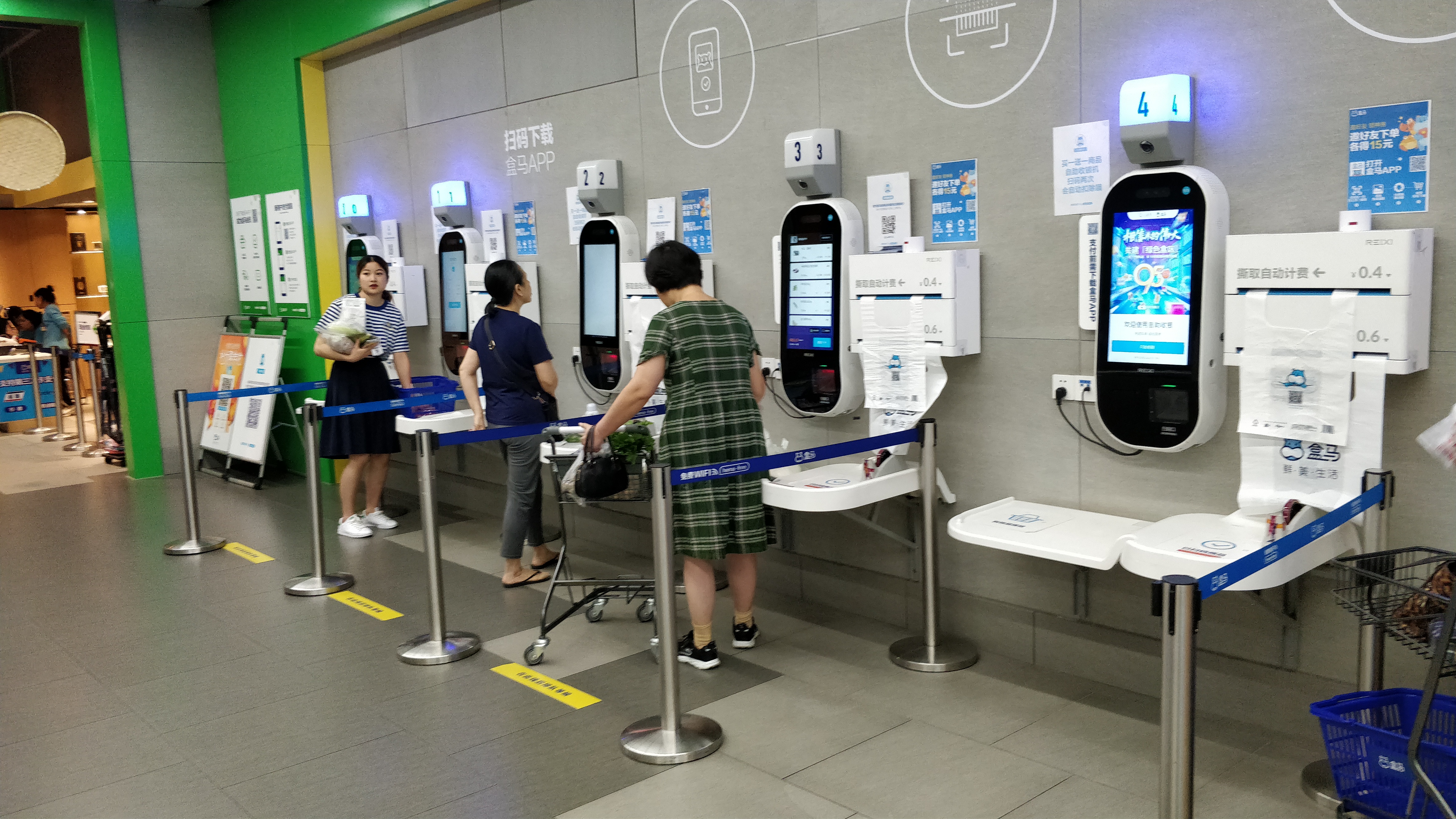


A Hema Farmers’ Market in Shanghai in 2019. (click on pictures to enlarge)
Hema Small Stations (盒马小站)
Hema Small Stations, the first of which opened in May 2029, were stores in areas where Hema was unable or unwilling to establish a full-fledged Hema Xiansheng store. The Small Stations mainly served as a front-end warehouse and only offered delivery (no store) within a 1,5 km radius. They were comparable to other companies using the front-end warehouse model, like Ding Dong Maicai, Meituan Maicai and Miss Fresh.
Regarding the front-end warehouse model, Hou Yi said: “I also use Dingdong Maicai and study them. I found that three problems cannot be solved. One is that there is no offline store. The second is the low gross profit margin. The third is that the daily waste of fresh products cannot be solved.” [4]
It is, therefore, no surprise that Hema Small Stations weren’t a success and were abandoned in March 2020, with some locations being upgraded to Hemi Mini stores (see below). Of all the Hema formats, this is the only one I haven’t had a chance to visit.
Hema Mini (盒马 Mini)
Hema Mini was one of the experimental formats the company opened in June 2019 as a community supermarket. At the time, big supermarket chains like Yonghui, RT-Mart and Carrefour were all testing small store formats. The concept focused on lower prices and target groups in the suburbs of first- and second-tier cities and other areas that did not meet requirements for a regular Hema Xiansheng, such as population density.
Also, where there was no room for a large Hema store, Alibaba would roll out the Hema Minis. They would find their way to the outskirts of major cities, but they were also suitable for smaller cities in China. Thus, Alibaba was hoping to eventually cover the whole of Shanghai and Beijing with Hema Mini locations, thereby greatly expanding the service area for home delivery.
Remarkably enough, the Hema Mini stores seemed to have the same target audience and purpose as the Hexiaoma stores that Hema had opened in cooperation with RT-Mart. This was the first sign that all wasn’t well in the camp…
There were clear differences between Hema Mini and regular Hema Xiansheng stores:
- The smaller size of 500-1,000 m2.
- As a result, a more limited product range (1,200 – 1,500 SKUs).
- More competitively priced than some other nearby supermarkets.
- Unpackaged vegetables instead of Hema’s characteristic bags with an indication of the weekday.
- A relatively large share of live and iced seafood products.
- No conveyor system under the ceiling (the store is small enough for order picking).
- Delivery within a radius of 1.5 instead of 3 kilometres.
- A much smaller surface area for catering. More sales of simple snacks.
- More opportunity for cash checkout to cater to older customers.
In short, a stripped-down version of Hema Xiansheng. While a Hema Xiansheng store costs at least 20 million yuan to open, a Hema Mini only costs 1/10th of that. Hema Mini stores mainly aimed to compete with conventional convenience stores like 7/11. Hema Mini would have a USP over these stores because it offered more fresh products, up to 40% of the assortment.
The initial plan was to completely self-operate Hema Minis, opening 100 stores per year, and have it make up 50% of Hema’s total revenue. Hou Yi even said, “The Hema Mini store is the ultimate model of fresh food e-commerce”. In practice, the lack of a franchise model resulted in slow expansion: it only opened 14 shops in 2019.

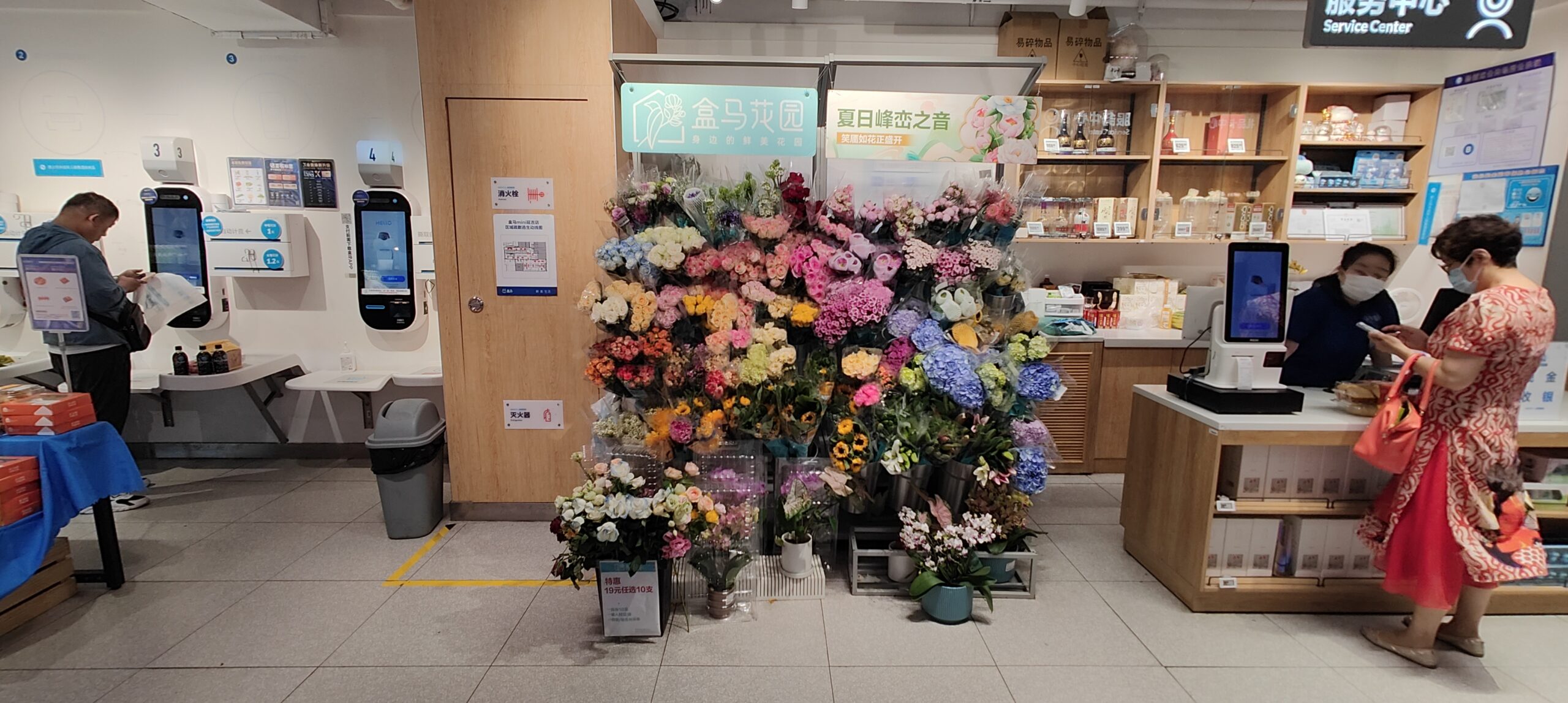



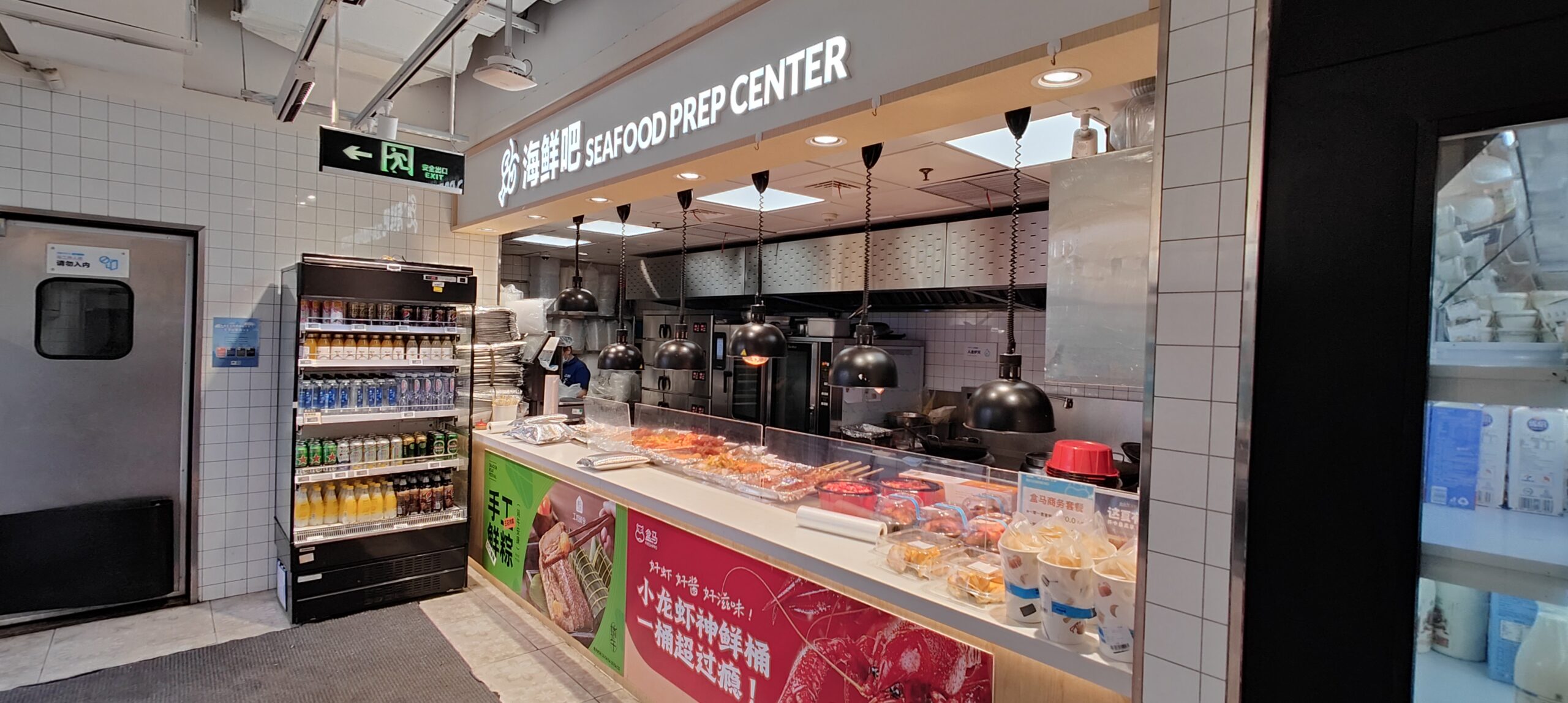
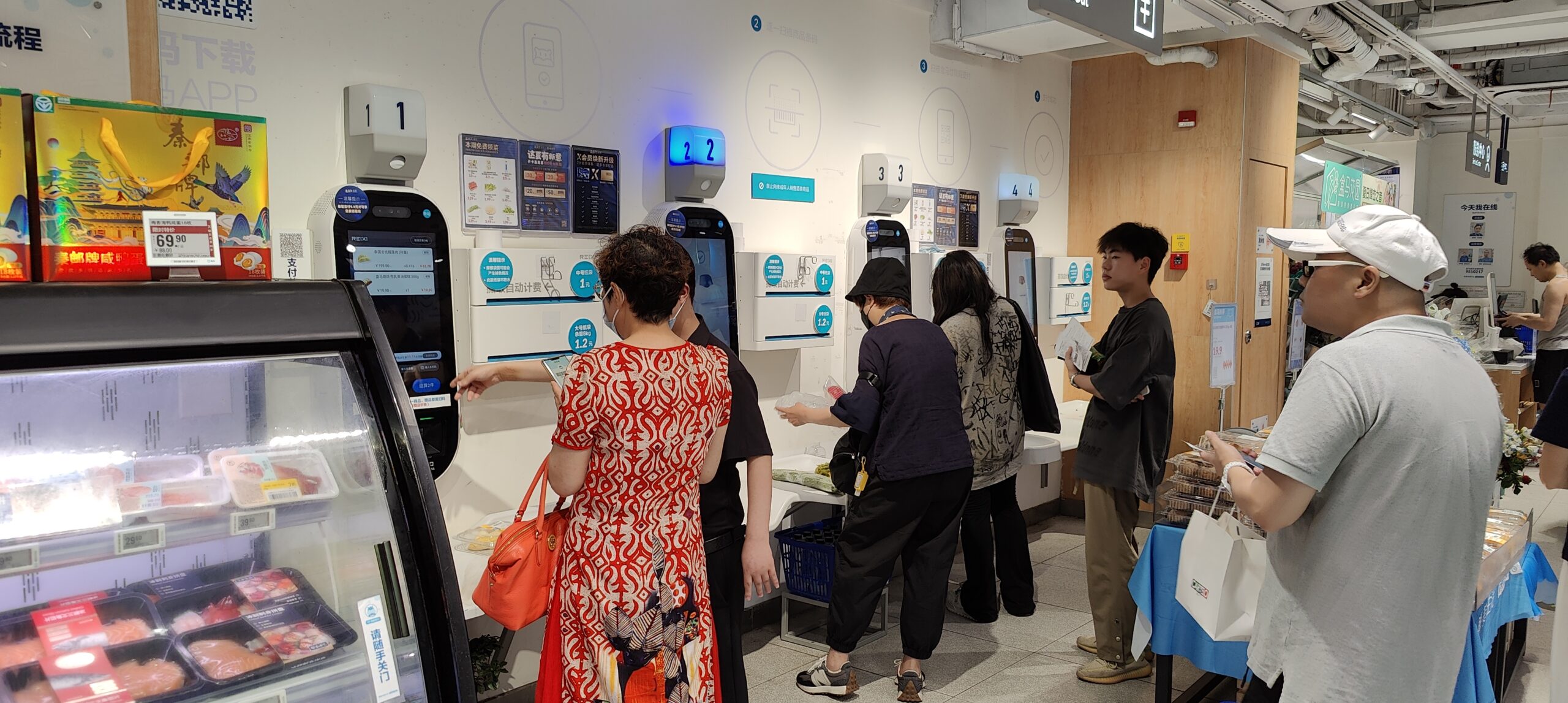
A Hema Mini in Shanghai 2023. (click on pictures to enlarge)
In March 2020, Hema announced that the six Hema Mini stores had proven the concept could be profitable and would be rolled out. The 70 Hema Small Stations would be closed, and many would be transformed into Hema Mini stores. [5]
Still, in August 2022, many Hema Mini stores in Beijing and Shanghai closed. According to Dianping, it only had 13 stores in operation by October. [3] Hema Mini currently only makes up 5% of Hema’s total revenue [6], quite a stretch from Hou Yi’s target of 50%.
One of the problems that Hema Mini has faced is intense competition. The concept is less unique than the Hema Xiansheng stores and therefore does not differentiate much from existing small supermarket chains. When the price at Hema Mini tends to be a bit higher, many consumers tend to vote with their wallets and will accept lower quality at other shops. Besides this, Hema Mini, which was separated from Hema Xiansheng, also had problems staffing its organisation, with frequent replacements and a lack of ambition.
With Hema Xiansheng and Hema Mini separated in the organisation, there was also the issue of competition. While online orders in the Hema app were geographically split into blocks, avoiding competition between the two formats, the same was not true for offline sales. After all, customers will decide themselves if they go to a nearby Hema Xiansheng or Hema Mini. Since Hema Mini does not offer catering, it could easily lose business to a nearby Hema Xiansheng. [6]
In 2023 it was reported that Hema planned another attempt to expand Hema Mini stores in the ‘sinking market’ (lower tier cities and rural areas) and open a large number of stores.
Hema Mall (盒马里, Hema Li)
As if small supermarkets and snack shops weren’t enough, Alibaba and shopping mall chain Shirble opened ‘Hema Li’, or Freshippo Mall, in Shenzhen at the end of November 2019. Like so many modern Chinese shopping malls, the 40,000 m2 Hema Li consists partly of shops and partly of restaurants. It had close to 60 tenants.
The idea behind Hema Li was that it could combine Shirble’s experience with offline malls and Hema’s online and digital expertise. At its opening, 100,000 products from the mall’s stores were available for online purchase. [7] Moreover, the mall was supposed to be a go-to place for weekend family outings. The mall was positioned as a ‘community mall’ and contained various household services, beauty salons, hairdressers and educational enterprises for children.
After the news of its opening in Shenzhen, little was heard from Hemi Mall. A Linkshop reporter visited the mall in April 2022 and found it almost deserted, unlike the shopping streets outside. [7] Many brands had already withdrawn from the Hema Mall, and many catering locations had closed, just as the former pharmacy, martial arts hall and children’s swimming pool. The ‘Hema Butler’ desk with community services had also disappeared. The picture book museum for kids had been closed. Hema Mall in Shenzhen was a shadow of the place it used to be…

Hema Li picture museum in 2019 (left, China Skinny [8]) and 2022 (right, source: Linkshop [7])
According to the Linkshop journalist, Hema Mall’s problem was that the surrounding area already had many options for groceries, both in supermarket chains and wet markets. As such, Hema Xiansheng was not an important reason for people to visit the mall. Some people would only go to the Hema Xiansheng in the mall during the evening when many fresh products were discounted. The educational enterprises in the mall had also been affected by the ‘double reduction’ policy that put limitations on profit-based after-school tutoring in 2021.
Of all the Hema concepts I visited, I was most challenged to get my head around this format. The Hema Mall I visited in Beijing was like a shopping mall (as in a group of stores) within a larger shopping mall. If it weren’t for the sign, you would not know you’d stepped into a Hema Mall. Besides the Hema Xiansheng inside the Hema Mall, there was little to link it to the Hema brand. Overall, it felt like a concept meant to create revenue from services to brands and reminded me of many failed cooperations with brands in Alibaba’s Tmall Smart Shop initiative.
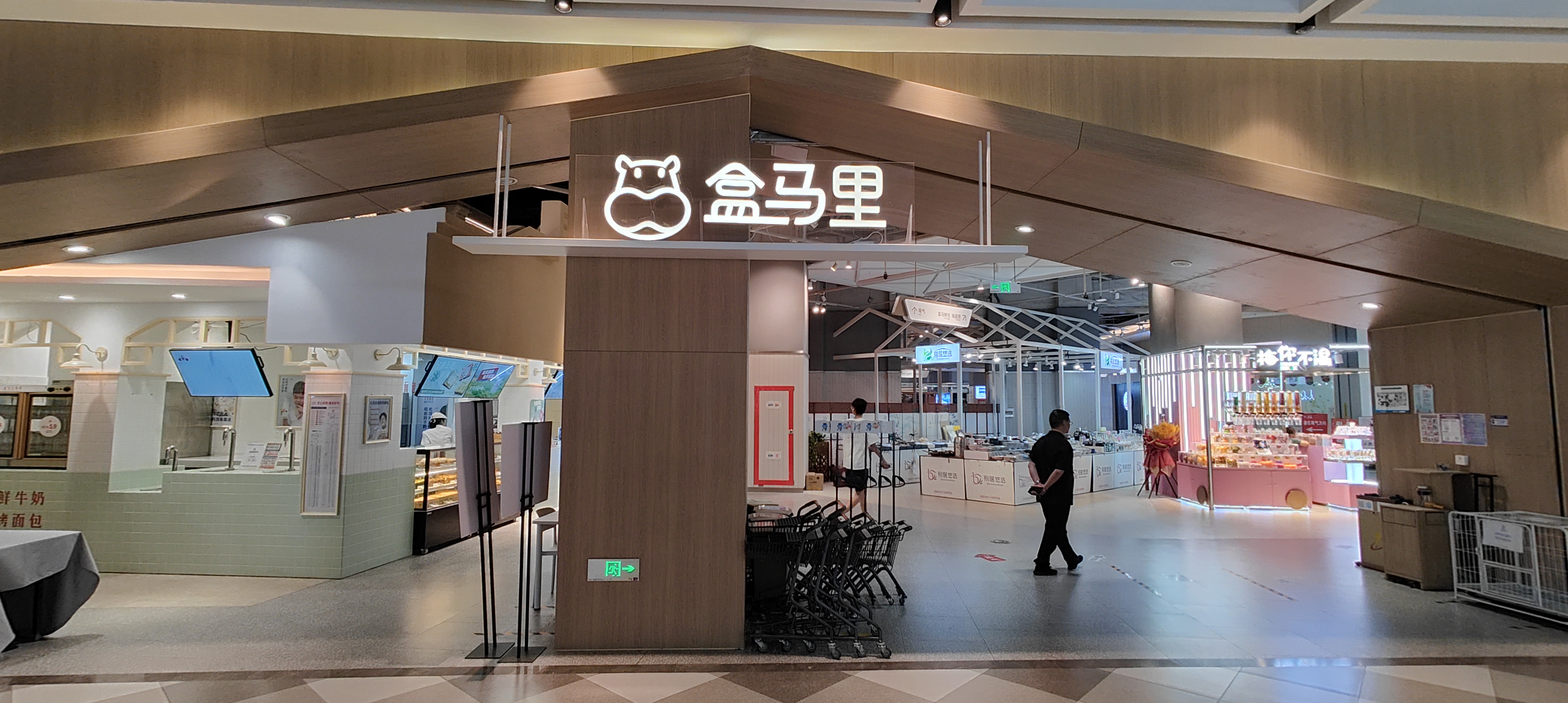
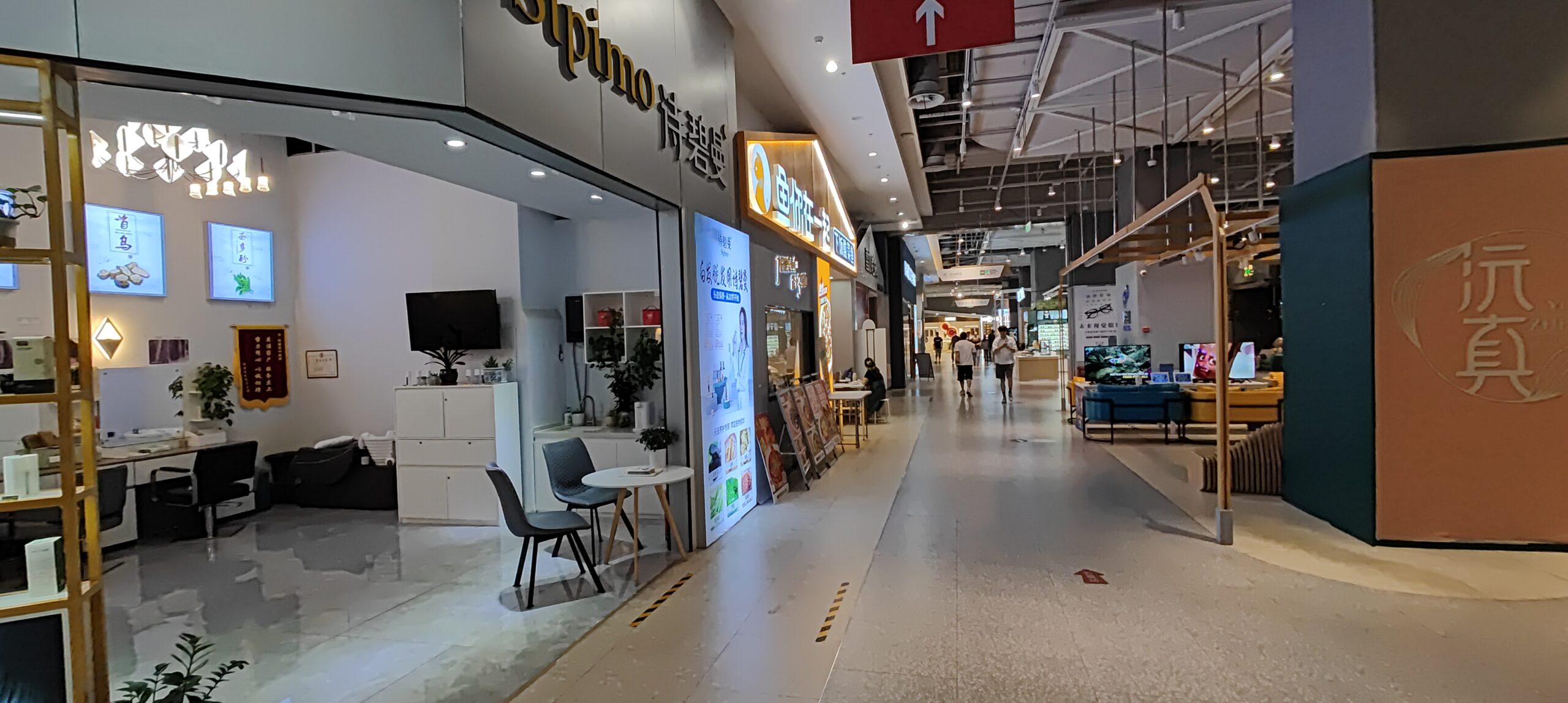

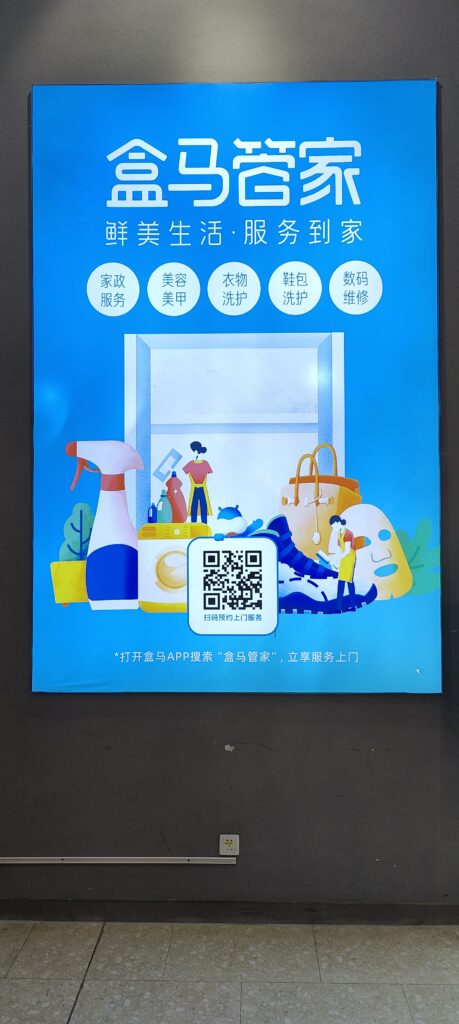
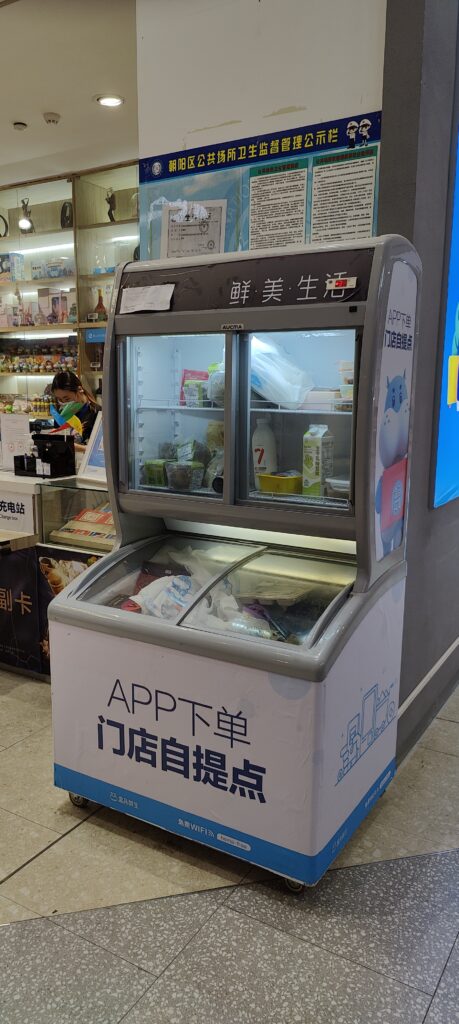
Hema Li in Beijing, 2023. Including a service center for pick up of items ordered online and Hema Butler (盒马管家 Hema Guanjia) services like housekeeping and manicures. (click on pictures to enlarge)
According to Baidu Maps, there were six Hema Malls in Beijing, Shenzhen, Wuhan, Shanghai, Hangzhou and Chongqing at the time of writing.
But when a colleague at Tech Buzz China visited the Hema Mall in Shenzhen, she found it was no longer there. Hema had purchased the naming rights for the building for a while, but when these expired, it was changed back to Shirble. It’s therefore questionable how active the other Hema Malls still are…

From Hema Mall back to Shirble (Shenzhen, March 2023)
Hema Pick ‘n Go / Hexiaoma (盒小马)
With Hema Pick ‘n Go, Alibaba opened a shop that sold (breakfast) snacks in the summer of 2019. The small 20-50 square meters shops offered about 40 different products, including the ‘jian bing’, an extremely popular breakfast pancake in China (see photo below). The average order value was RMB 20-30, which is relatively high compared to many hole-in-the-wall shops and street sellers that sell the same goods.
Pick ‘n Go was competing with the breakfast offerings of many established fast-food chains like McDonald’s, KFC and Burger King, which had also successfully launched Chinese breakfast options. But Pick ‘n Go claimed to have USPs in having more Chinese food types and higher ordering convenience. Customers could place an order via the Hema app and, on their way to work, pick their food up in a locker to avoid long queues during rush hour. The concept was advertised as “order food in 10 seconds on your mobile phone and sleep 10 minutes longer every day”.
As seen in the video above, some Hema F2 stores also incorporated a Pick ‘n Go locker system.
Unfortunately for the writer, a big jian bing enthusiast, the store was closed for maintenance at the time of my visit, but photos could be found on the Chinese review site Dianping (right).
About 90% of the products sold at Pick ‘n Go was shared with Hema Xiansheng. These products were pre-produced at Hema’s central kitchens. [9]
In July 2020, after having tested the concept for a year, Hema announced that Pick ‘n Go had been ‘upgraded’ to Hexiaoma (盒小马) and that it would open 60-80 Hexiaoma stores covering the entire Shanghai subway line system, business districts and core office buildings. [10/11] This was confusing because, as we’ve seen, Hema had been running a different kind of store, a small supermarket, under the same brand in cooperation with RT-Mart. Clearly, something was amiss in the cooperation between the two parts of the Alibaba conglomerate.
Since its launch, the catering offerings of the RT-Mart Hexiaoma had disappeared and there was little left to link it to the Hema brand. In January 2021, the ownership of the Hexiaoma supermarkets was fully transferred to RT-Mart when it bought Alibaba’s 51% of shares. At the time, RT-Mart’s Hexiaoma had just 14 stores, 2.5 years after launching. [11] RT-Mart announced that they might be renamed to Xiaorunfa (小润发), after RT-Mart’s Chinese name Darunfa (大润发). RT-Mart had already been opening Xiaorunfa stores since mid-2020. [5]
Meanwhile, Hema aimed to open 1,000 Hexiaoma Pick ‘n Go stores in 3 years. But in 2021, review site Dianping only showed nine stores. [11] Meanwhile, Bailian Group and Alibaba Group have jointly invested in another convenience store named Yike EGO (逸刻EGO). Last month in Shanghai, we came across a Yike location that offered a comparable concept to Pick ‘n Go. However, the person running the Yike store told us they no longer use the locker wall system. It, therefore, isn’t a surprise that Pick ‘n Go is another Hema concept that hasn’t survived.
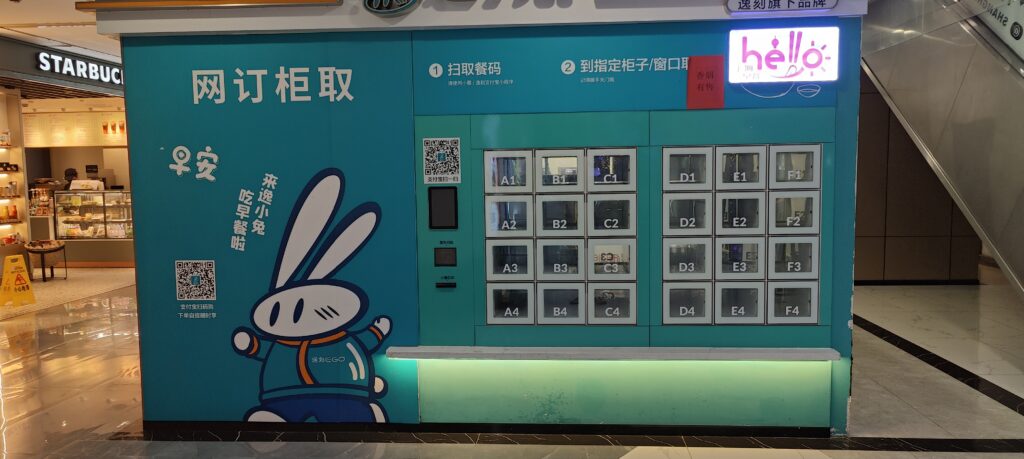
An unused Yike EGO locker system in Shanghai in 2023.
When writing this article, I only found one ‘Hexiaoma’ store in China. The most recent picture showing an ‘RT-mart version’ was taken in April 2022. A search for Xiaorunfa resulted in many search hits in Shanghai. Therefore, we can safely assume neither Hema concept has survived, and this tale that reeks of internal friction between RT-Mart and Hema has ended.
Will the real Hexiaoma please stand up? (image source: Baidu Maps)
And there you have it; of all the concepts Hema launched from 2017 to 2019, only Hema Mini and, to a certain extent, a faltering Hema Mall, have survived. But they are nowhere near the scale that Hou Yi had envisioned.
This wasn’t the end of Hema throwing things at the wall and seeing what sticks. In the past three years, it has launched Hema Jishi, Hema Neighbourhood, Hema X and Hema Outlet, and there’s more in the pipeline. We’ll tell you all about it in part 3 of this series. Stay tuned!
On Alibaba’s Investor Day 2020, it hailed Hema as ‘the first successful new retail omni-channel model built in the world’. But three out of four concepts shown on the slide would be failures…
[1] Linkshop 2023-04-18, [2] ikanchai.com 2019-10-04, [3] 钛媒体 2022-10-20, [4] 金角财经 2023-07-11, [5] Jiemian 2021-01-21, [6] Tech Buzz China 2023-06-09, [7] Linkshop 2022-04-13, [8] China Skinny 2019-12-03 , [9] digitaling.com 2020-08-25, [10] 连锁产业观察 2020-07-15, [11] Sina Finance 2021-01-18


